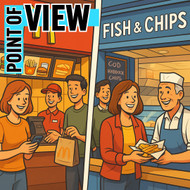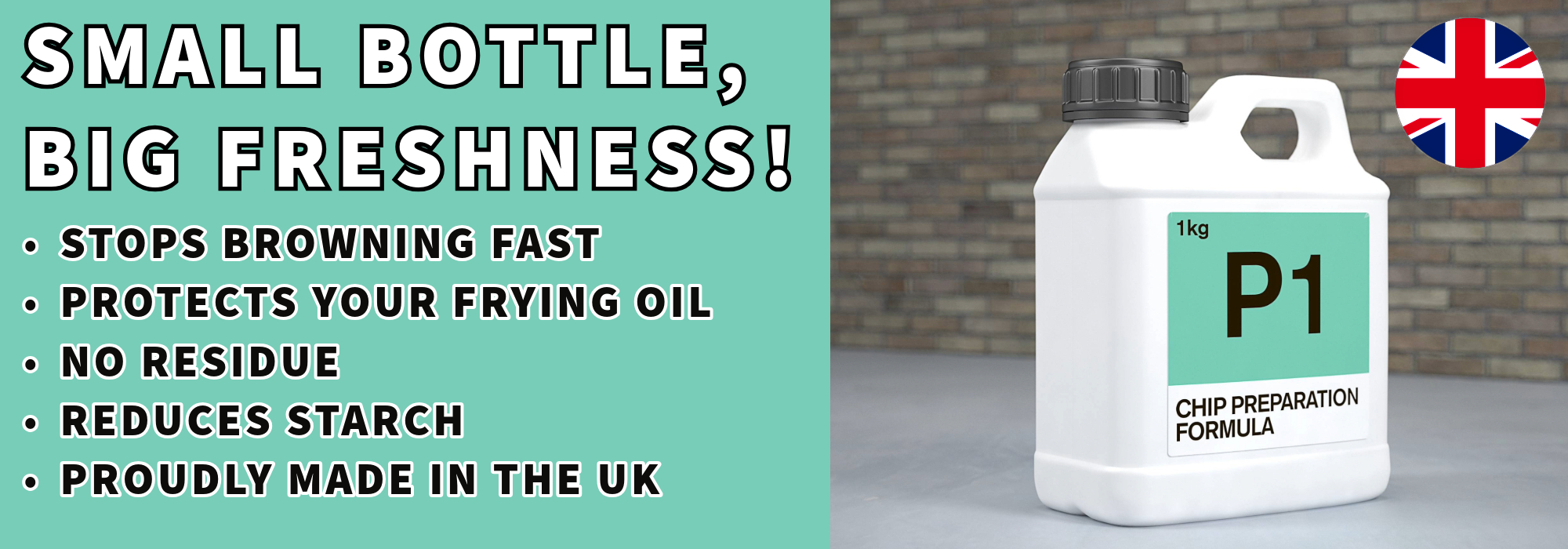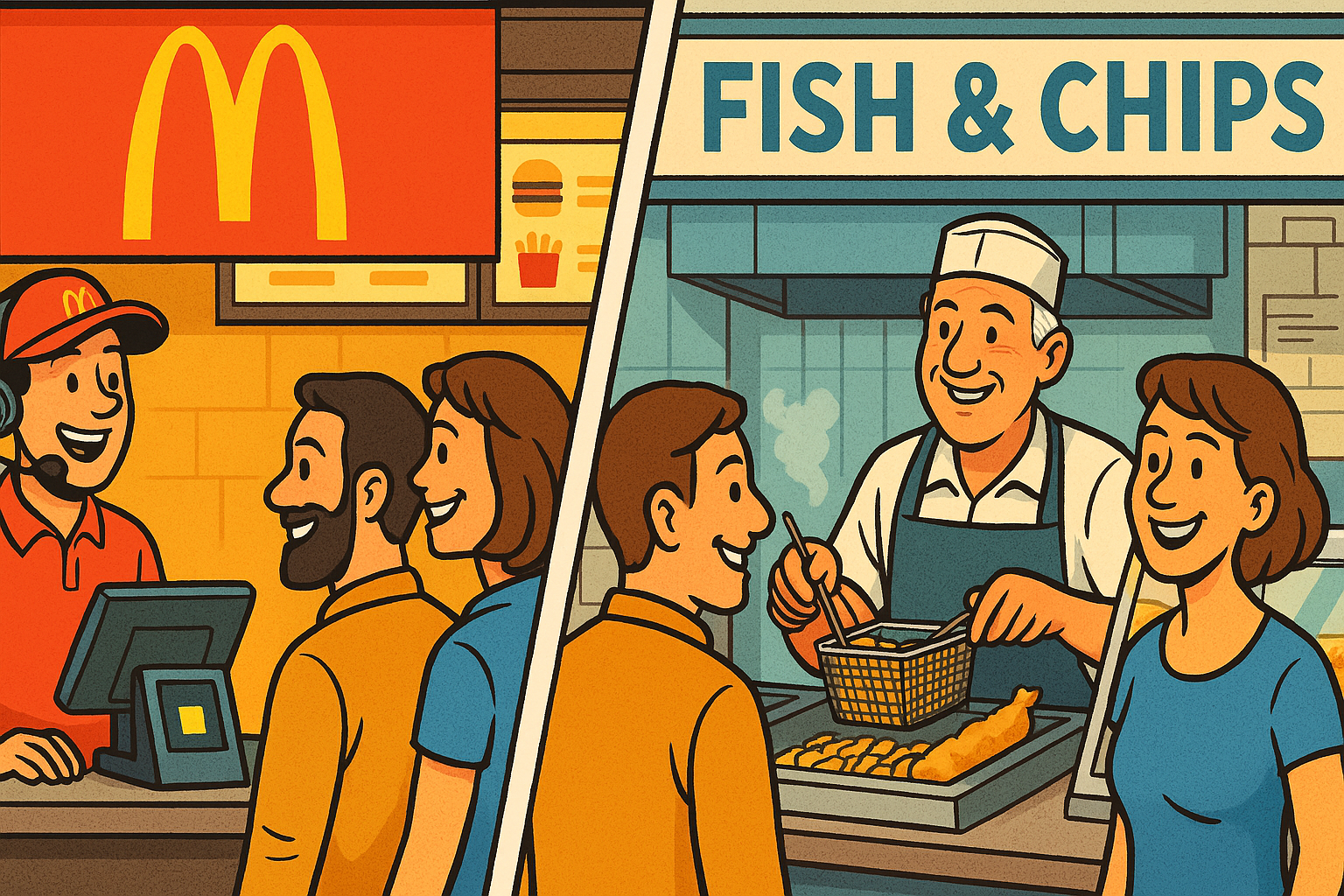The Fish & Chip Shop Advantage McDonald’s Can’t Buy
Posted by Stelios on 16th Aug 2025 Reading Time:
If McDonald’s can measure service times in tenths of a second, why are some of us still letting customers wait minutes?
That was the question that struck me when I read about their new “Ready on Arrival” system. Using geofencing technology, McDonald’s can tell when a customer with a mobile order is a few minutes away, so the kitchen team can start cooking before they even walk through the door. The result? Waiting times cut by more than 50%. In some cases, customers don’t wait at all.
For a business that operates at a mind-bending scale—tens of thousands of restaurants, serving millions daily—that’s transformative. But it’s also a reminder: speed isn’t just about speed, it’s about perception, preparation, and experience. And that’s something we in the fish & chip industry can learn from.
The Hot Box, the Fryer, and the Human Connection
When I worked in my dad’s fish & chip shop, we didn’t have geofencing apps or Google partnerships. If it was quiet and we didn’t have a regular fish in the hot box, we’d say: “We’ve got some in the fryer now, just topping up.” Customers didn’t feel like they were waiting—because they believed their fish was fresh and nearly ready.
The actual time might not have been much different, but the perception was transformed. Sometimes, a short wait feels like a bonus if it’s framed as “freshly cooked just for you,” while the same wait feels painful if it’s framed as “sorry, nothing ready.”
And this is where the human connection matters most. Talking to customers and showing them you’re active—topping up the hot box, giving the counter a clean down, or chatting with them about the world or their day—makes the time fly by. Compare that to the opposite: you take their order, slowly walk over to drop the fish in the fryer with no sense of urgency, then stare at your phone for six minutes. To the customer, that wait feels like a lifetime.
We always found ways to make waiting more pleasant: music on the radio, the news on TV, newspapers on the counter. But above all, it was the conversation—the human connection—that kept customers engaged. A simple chat can make two minutes feel like 20 seconds. That sense of recognition—“How’s your day been?”, “Did the kids enjoy school?”, “Off anywhere nice at the weekend?”—is still king.
The Stress Factor
McDonald’s executives admit their restaurants can be stressful places—customers at the counter, queues at the drive-thru, couriers piling in for deliveries. Sound familiar? On a Friday night in a fish & chip shop, it’s the same.
That’s why they’re investing billions in tech: kitchen systems that anticipate orders, AI that spots equipment faults before they happen, digital alerts to help staff sequence cooking better. It’s not just about speed—it’s about reducing staff stress so they can deliver service with a smile.
For us, the lesson is clear: less stress in the shop means a better experience for the customer. That doesn’t need to be fancy AI—it might be as simple as a screen to track orders, clearer roles for each team member during a rush, or pre-cooking the most common items before the surge hits. Sometimes it’s about having a staff member act as a dedicated runner—the one who does all the odd jobs like preparing batter, filling chip baskets, or topping up curry sauce—so the frying and serving staff stay focused. And if things are hectic, putting one person solely on curry and peas can keep everything flowing smoothly.
Anticipation is Everything
McDonald’s “Ready on Arrival” works because it anticipates the customer’s need before the order hits the counter. But here’s the thing—we’ve always had that ability, we just sometimes forget to use it.
If 90% of your Friday night orders are regular cod or haddock, why wait for the till to ring before you drop them? If you know curry sauce and mushy peas will sell, have them hot and ready. That anticipation makes the line move quicker, keeps stress down, and improves the customer’s perception of value.
Of course, this doesn’t mean holding food for hours. Fish takes around six or seven minutes to fry—you don’t need an hour’s worth sitting in the hot box. But it is logical to look down the queue and at your online orders, work out how many are going out, and have one or two extra ready. Many customers are happy to wait for fresh food, but many don’t want to wait at all. Finding the happy medium is key. Realistically, not everything can be fried to order, but it can be fried just in time.
Speed, Volume, and Winning More Customers
Let’s not forget—McDonald’s isn’t just speeding up service for the fun of it. Faster service means they can serve more customers, more often. It’s a volume game. The quicker they move people through, the more transactions they capture without needing extra staff or space.
This is where fish & chip shops can win too. If a customer has a 45-minute lunch break, waiting 15 minutes for a cod and chips just isn’t going to seal the deal. As much as they fancy it, they don’t want to lose a third of their break standing around. People today are increasingly time-poor, and we need to tap into the speed we already have at our fingertips with the fryers. Done well, fish & chips can be one of the fastest hot meals available—but only if we anticipate demand and keep the flow moving.
And here’s the real kicker: the more customers you can serve per hour without adding more staff, the more profit you make. Let’s put some numbers to it. If each server can serve just two extra customers per hour, that’s eight more per shift. Multiply that by three servers and you’re looking at 24 extra customers per shift. At an average spend of £10, that’s an additional £240 per shift. Not bad for simply shaving off waiting time and keeping the line moving.
The Industry-Wide Arms Race
McDonald’s isn’t alone. Domino’s has its pizza tracker. Starbucks is pushing faster service during the morning rush. Shake Shack’s CEO admitted their drive-thru waits are too long. Speed and convenience are the battlegrounds across the whole food industry.
That should make us ask: if customers are experiencing faster service at all these brands, how patient will they be with us if we lag? The benchmark of “acceptable waiting time” is moving—and it’s moving fast.
So What Can Fish & Chip Shops Do?
Here are a few takeaways from McDonald’s playbook, translated into our world:
- Perception management – Frame waits as “freshly cooked just for you,” not “sorry, nothing ready.”
- Customer distraction – Use music, news, newspapers, and conversation to make waits feel shorter.
- Anticipate orders – Don’t wait for the till to confirm what you already know—get ahead with your most popular items.
- Prep for flow – Streamline the journey from fryer to counter to prevent bottlenecks.
- Build loyalty – Whether it’s cards, offers, meal deals or personal recognition, give customers a reason to come back.
The Final Thought
McDonald’s is spending billions on geofencing, AI, and tech partnerships. We don’t have that budget—but we do have agility, community, and human connection.
The real question is: are we making the most of what we’ve got?
Whether it’s McDonald’s in Times Square or a chippy in a seaside town, the clock is always ticking—on every order, every customer, and every chance to win them over again.
Anyone can make a sale. But turning that customer into a regular, and then into a customer for life—that’s a different concept entirely. And that’s where independents can truly outshine the giants.







